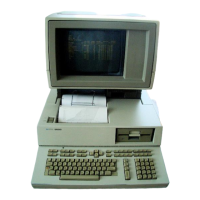3-16
Testing
and
Troubleshooting
Real-Time Clock/Non-Volatile Memory (RTC/NVM)
The keyboard processor board contains the RTC
and
NVM
chips
and
the battery assembly to
maintain the chips during power-off states.
The RTC
and
NVM
chips store a clock, system configuration data,
and
service information of
significance to users
and
service personnel. The clock
is
initially loaded from the lOP
and
is
updated
by a crystal oscillator. The RTC chip stores clock
and
calendar data
in
16
four-bit locations; the
NVM
chip has
2048
eight-bit locations
and
stores service
and
configuration data. RTC/NVM
locations
and
contents are as follows:
Byte
0 -
Byte 1 -
Byte 2 -
Byte 3 -
Byte 4 -
Byte 5 -
Byte 6 -
Byte 7 -
Byte 8 -
Byte 9 -
Bytes
10-13 -
Byte
14
-
Byte
15
-
Byte
16
-
Bytes
17-24
-
Bytes
25-44
-
Byte
45
-
Bytes 46-47 -
Bytes 48-53 -
Bytes
54-57
-
Bytes
58-60
-
Byte 61 -
Bytes 62-63 -
Second
Clock Check Byte
Minute
Stack Size (two times number of boards)
Hour
Century
Day of Week
Day of Month
Month
Year
Control Registers
Timer Resolution
Timeout Scan Resolution
Keyboard Initialization Data
Default System Startup Subsystem
Default Mass Storage Unit Specifier
Size of System
110
Buffer
NVM
Checksum
Healer
CAM
Overflow Counter
Last Double Bit Memory Failure Data
Number of 10-Minute
Periods Computer
is
On
Number of Overheat Cycles
Number of
Power-On Cycles
The keyboard processor board contains a nickel-cadmium battery assembly consisting of four
batteries to maintain the RTC
and
NVM
chips during a power-off condition. Because only three
batteries are required,
one
is
redundant. This enables the chips to operate without error
if
one
of the
batteries has a short circuit. The battery assembly maintains RTC
and
NVM
data for a minimum of
10
days while power
is
off.

